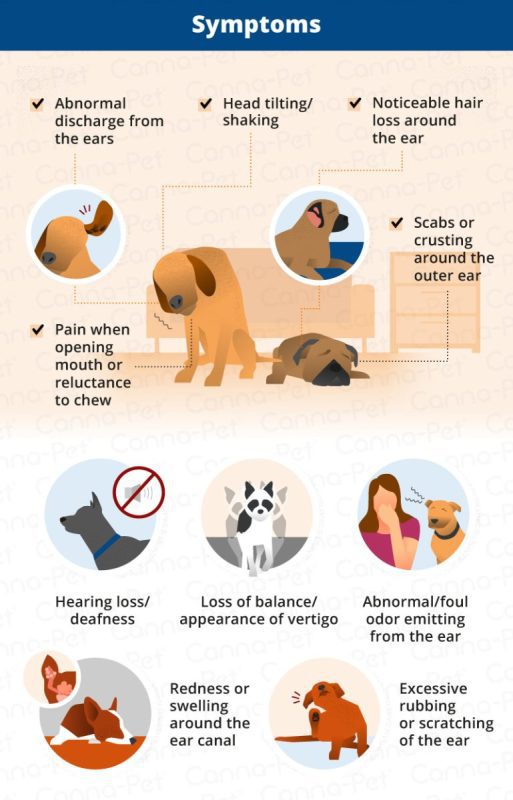
Clinical signs of ear fungus in dogs
As part of a routine physical examination, the veterinarian examines the dog’s ear canal using an otoscope, a special medical device with a light. Any discomfort, redness in the ear canal, or excessive wax buildup that a doctor can detect are signs of an ear infection.
Ear fungus in dogs usually develops when there is excess moisture in the ear. As a rule, the infection begins in the external auditory canal, it is called otitis externa. If the infection is not treated, it can progress and affect the middle ear canal – this is how otitis media occurs. The inner ear can also be affected – and then internal otitis develops.
Contents
Clinical signs of ear fungus in dogs
Otitis media can cause both physical and behavioral symptoms in pets. Ear infections do not go away on their own and can progress quickly, so if you have any clinical signs, you should immediately make an appointment with a doctor.
Otitis media has the following physical clinical features:
- Redness of the skin.
- Hair loss on outer ear.
- Darkening of the skin (hyperpigmentation).
- Visible crust on the auricle.
- Erosions and ulcers.
- Allocations.
- Bleeding.
- Swollen or narrowed ear canal.
- Warm to the touch ears.
- Unusual smell from ears or head.
Behavioral clinical signs of otitis that are important for pet owners to be aware of include the following:
- The pet scratches its head or ears.
- Shakes his head.
- Rubs head on floor, furniture or walls.
- D Doesn’t eat well.
- Behaves sluggishly.
- Exhibits increased sensitivity to touch.
- She pulls her head away when she tries to touch her.
- Grunts or squeals when scratching ears.
- Doesn’t hear well.
- Experiencing balance problems*.
- Walks in circles*.
* It is important to understand that this symptom is not seen in most ear infections, but is more common in infections affecting the inner or middle ear.
Ear fungus in dogs: breeds at risk
The dog’s ear is a warm and humid environment ideal for yeast and bacteria to thrive. A variety of factors can lead to an imbalance in yeast or bacteria, regardless of gender, ear shape, exposure to water, or the amount of hair in the ear canal.
Dog breeds with floppy ears such as Basset Hounds, oily coats such as Cocker Spaniels, and those with a tendency to allergies such as Labrador Retrievers are reported to be especially susceptible to severe or chronic ear fungal infections. It is believed that allergens are a significant factor, which provoke the inflammatory and infectious cycle of ear infections.
Ear mites are more common in puppies and dogs with weakened immune systems, but occasionally affect healthy adults. Bacterial and fungal ear infections can develop in dogs of all ages.
While most dogs develop an ear infection at least once in their lifetime, yeast infections often occur in association with other conditions. According to the Canadian Veterinary Journal, some of these are:
- Food allergy.
- Atopic dermatitis in dogs is an allergy to environmental components.
- Ear parasites such as Otodectes cynotis or the common ear mite.
- Contact hypersensitivity.
- Hormonal disorders such as low thyroid and adrenal disease.
- The ingress of foreign bodies, such as blades of grass.
- Neoplasms in the ear canal, such as polyps or tumors.
Signs of Ear Mite, Fungal Infection, and Bacterial Infection in Dogs
If your pet has a moderate to significant amount of dark brown or black discharge from the ear, this may indicate the presence of an ear mite. In this case, it is possible that this will be accompanied by a bacterial or fungal infection. In general, tick infections cause drier exudates than yeast or bacterial infections.
Your veterinarian will perform an analysis to determine what type of microorganism is causing the ear infection and associated inflammation. Using a clean cotton swab, he will place a sample of exudate from the dog’s ear canal onto a glass slide and stain it for examination under a microscope.
If the specialist suspects the presence of an ear mite, he will mix the exudate with mineral oil and examine it under a microscope. Ticks in this case begin to move, and they are easy to observe. This cytological analysis is the most informative diagnostic test for otitis media. Ear swabs and cytology are also helpful in monitoring the dog’s response to treatment. In severe chronic cases, exudate specimen culture or imaging studies may be required, but this is the exception rather than the rule.
Treatment and prognosis for ear fungus in dogs
Based on the results of the smear and cytological examination, the veterinarian will prescribe medications. Usually, topical ear cleaners, topical medications, and sometimes oral medications are prescribed in such cases. Additionally, medications for itching, painkillers and anti-inflammatory drugs may be prescribed. To quickly get rid of the infection, you must strictly follow the instructions of a specialist. Tick ear infections can also be treated with topical external parasite treatments.
If the veterinarian detects mild otitis externa in time, and the owner follows his recommendations, the pet will have an excellent chance for a quick recovery. In cases of infection progressing to the middle or inner ear, treatment may be longer. Some bacterial ear infections are difficult to treat and often recur. Dogs with these infections are at risk for permanent damage, including deafness. In severe and chronic cases, an operation to open the ear canal may be required – a complete ablation of the ear canal. Cleaning your dog’s ears regularly after getting rid of an infection helps prevent recurrence and promotes overall health and wellness.





